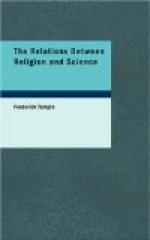Further, it is necessary to repeat what was briefly remarked in a previous Lecture, that the position which miracles take as regards us who read them many centuries after, and as regards those who witnessed and recorded them at the time, is quite different. To them the miracles were the first and often the chief proof that the man who wrought them had been sent by God, and that His message was a revelation, not an imposture; to us they are, if accepted at all, accepted as a part of the revelation itself. There are no doubt a few minds that are convinced by Paley’s argument, and beginning with accepting the miracles as proved by sufficient external evidence, go on to accept the conclusion that therefore the teaching that was thus accompanied must be divine. But most men are quite unable to take to pieces in this way the records in which Revelation is contained, and to go from external evidence taken alone to the messengers who thus proved their mission, and thence to the substance of the message which they taught. To most of us, on the contrary, the Revelation is a whole, capable of being looked at from many sides, and found to be divine from whatever side it is seen; and one of its aspects is this supernatural character by which it appears to assert its identity with that Moral Law which claims absolute supremacy over all the physical world. The main evidence of the Revelation to us consists in its harmony with the voice of the spiritual faculty within us; and the claim which it asserts to have come through teachers endowed with supernatural power is so far corroborative evidence as it falls in with the essential character of the Moral Law. That eternal law claims supremacy over the physical world and actually asserts it in the freedom of the human will; and a Revelation which comes from Him Who in His own essential Being is that very law personified, might be expected to exhibit the same claim in actual manifestation in its approach to men.
Bearing these limitations and characteristics of the miraculous element in the Bible in mind, let us ask how that miraculous element is therein presented.




